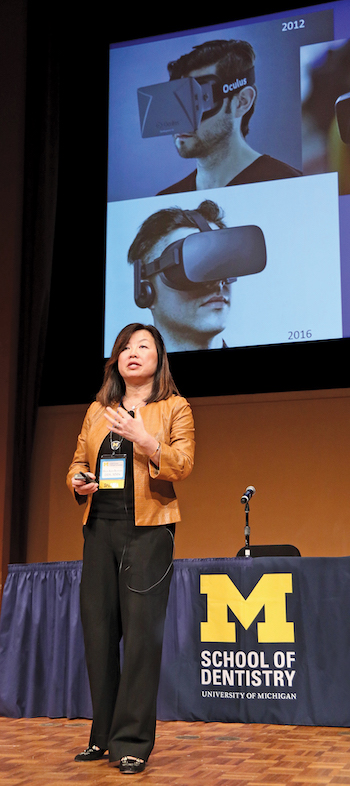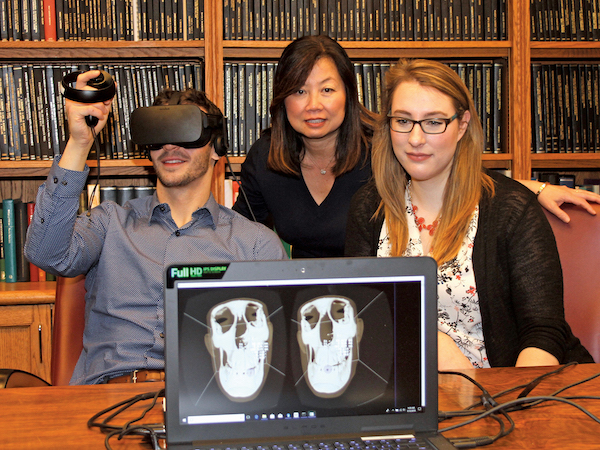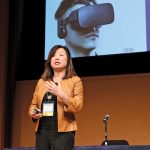Faculty Profile: Dr. Hera Kim-Berman7 min read
Virtual Reality offers exciting opportunities for dental education
This profile, originally published in the Spring 2019 edition of the M Dentistry alumni magazine, is one in a series highlighting School of Dentistry alumni, donors, faculty and students.
Ann Arbor, Mich., May 13, 2019 — Educating dental students has changed in many significant ways since School of Dentistry faculty member Dr. Hera Kim-Berman was in dental school in New York in the late 1980s, but she has a favorite story to illustrate that many things have remained much the same.

One of her first assignments back then was to contact local dentists and collect teeth they had extracted from their patients. The teeth were used to help students identify and learn about the 32 teeth in the human mouth. Even today, beginning dental students take hands-on tooth anatomy tests where they pick up and examine one tooth at a time in order to identify its number or to answer other questions. It is a time-consuming task for a class of more than 100 students and their faculty.
That low-tech but effective teaching method may soon take a new form, along with many other much more complex aspects of dental education. Computer technology has been advancing rapidly for decades, but the latest chapter featuring Virtual Reality, or VR, has especially exciting prospects — and challenges — for educators in dentistry.
Kim-Berman is out on the frontier of the new technology, investigating whether and how to adapt it to existing didactic and clinical methods. In what areas can VR help dental students learn? Is it better or faster? How much training time and expense will it require? Can it improve quality of care? Is any of this ready to be incorporated into the curriculum?
Kim-Berman is a clinical assistant professor in the Department of Orthodontics and Pediatric Dentistry and Director of the Graduate Orthodontic Program. During a presentation at the annual Moyers Symposium at U-M in March, she explained the technology’s exciting potential for both patient care and dental education, and the need to study and validate that it can be an effective alternative to traditional teaching methods and curriculum.

VR is defined as full immersion in an artificial environment, totally generated by a computer, that the user can interact with. In the case of dental students and faculty, they wear Oculus Rift headsets that look like large goggles covering their eyes. Once in the VR scene, they see an image of a patient created by using Cone Beam Computed Tomography (CBCT) scans. With hand gestures and head movements, as though the user were holding an object in the real world, the user can rotate the patient’s virtual image in all directions to more closely examine the patient’s anatomy for diagnosis. The detailed images can be used to devise treatment plans for orthodontic and surgical solutions.
The 3-dimensional view provides more realistic detail than the longstanding method of imaging patients with lateral- and front-view radiographs, then cutting apart and rearranging the transparencies to envision the best way to treat various conditions. Even the vast digital imaging improvements of the last 20 years on computer screens provide only two-dimensional views. “For many years we’ve taught residents how to simulate jaw surgery using a two-dimensional radiograph,” Kim-Berman said. “VR is better in that we can get all three planes of space imaged. Then I can manipulate the skull so that I can look at it from a worm’s eye view, a bird’s eye view and even from the back of the patient’s throat. That’s something you can’t have with just an x-ray or just a computer screen.”
Kim-Berman is focusing on two areas in her early push to explore the potential of VR. First, she has created a Virtual Dental Library of human teeth, ideal resin teeth and examples of student preparations from operative dentistry and prosthodontics that students can access on their smart phones and other portable VR headset options, such as the Oculus Go. Using the Virtual Dental Library, students can view the virtual contents from anywhere, when studying for a test or self- assessing their own work. Instead of lining up in a classroom or lab to physically pick up a tooth to identify it for a tooth anatomy test, students could access a virtual tooth identification test anytime and anyplace, rotating the image in all directions and closely inspecting it to complete the test.
The second, more complex focus for Kim-Berman is collaborating with computer programmers, enterprise, and faculty colleagues, including oral and maxillofacial surgeons, to create the VR Patient for corrective jaw surgery that can be used as an educational tool. Rendered CBCT patient data can be used to create multiple VR patient modules with varying complexity that can be manipulated multiples times by a student to explore different surgical options. It is somewhat time-consuming to create each VR patient and it must be run on a computer with a sophisticated graphics card, along with the Rift headset and hand controllers. Despite the limitations, VR is already showing progress in orthodontic and surgical applications.
Kim-Berman and other faculty have introduced VR to the general student body as well, on a small scale. Students have volunteered to test their VR-learning versus their traditional, non-VR comprehension. The early results are promising though far from conclusive. Two orthodontics residents, Dr. Lauren Sytek (DDS 2017) and Dr. Jason Sherbel (DDS 2018), are researching VR education for their master’s thesis projects. This summer’s incoming Class of 2023 will be the first to find VR in their coursework, though on a limited basis.
“The hindrance of introducing any new technology is the lack of validation and evaluation,” Kim-Berman said. “In my job as an educator, I can’t just bring in new technology and tell students this is going to help you, so just do it. I think it’s important for us to change constantly, to move with the times and introduce technology, but it must be evidence-based.”
“I think this technology is going to be valuable in so many ways — treatment planning, learning about unique cases, improving education, easily available to a lot of people. I think the possibilities are really endless.”
###
The University of Michigan School of Dentistry is one of the nation’s leading dental schools engaged in oral health care education, research, patient care and community service. General dental care clinics and specialty clinics providing advanced treatment enable the school to offer dental services and programs to patients throughout Michigan. Classroom and clinic instruction prepare future dentists, dental specialists and dental hygienists for practice in private offices, hospitals, academia and public agencies. Research seeks to discover and apply new knowledge that can help patients worldwide. For more information about the School of Dentistry, visit us on the Web at: www.dent.umich.edu. Contact: Lynn Monson, associate director of communications, at [email protected], or (734) 615-1971.

